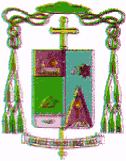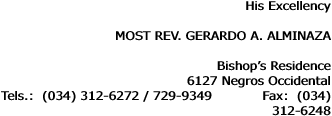The Catholic Bishops' Conference of the Philippines
The Official Website of
CBCP Online

In line with its vision and mission, and the directions set by the Second Plenary Council of the Philippines, the diocese has embarked on its diocesan thrust: the formation of Basic Ecclesial Communities. About 567 BEC's have become operative in the region since 1988. The various commissions have pursued their respective programs in the parochial and diocesan levels. And all these have brought about a greater awareness of the faith.
The socio-economic programs are being implemented through the Social Action Center (SAC). And most effective in improving the socio-economic climate are the small cooperatives in 12 parishes and 3 chaplaincies. The SAC is also helping feed 9,800 malnourished children and their mothers, supplementing material help with nutrition information and the introduction of herbal medicines, acupuncture, etc.
Summarily the Diocese of San Carlos is much involved in the delivery of services through its varied apostolates, specially to the poor and the marginalized. As to its financial viability, the diocese is now implementing the tithing system in 12 parishes
The Diocese of San Carlos occupies a territory on the northeastern part of Negros Island comprising 4 municipalities of Negros Oriental, and 7 of Negros Occidental including the City of San Carlos which is the see of the diocese.
The history of the Diocese of San Carlos is very closely linked with that of her sister dioceses on the same island: those of Bacolod, Dumaguete and Kabankalan. Its territory was carved partly from the Diocese of Bacolod, and partly from the Diocese of Dumaguete. The day of its creation coincides with that of the Diocese of Kabankalan, which covers the southern portion of Negros Occidental.
Way back during the Spanish era, the island of Negros was part of the then Diocese of Jaro when this was created in 1868. Negros stayed under the jurisdiction of the Jaro diocese until 1933, when the Diocese of Bacolod was created and the entire island of Negros was placed under its jurisdiction. When the Diocese of Dumaguete was created in 1955, it was separated from that of Bacolod.
Finally, on March 30, 1987, the Diocese of San Carlos and the Diocese of Kabankalan were created and these two new ecclesiastical territories were separated from the jurisdictions of Bacolod and Dumaguete. All four dioceses on Negros Island are now suffragans of the Archdiocese of Jaro.
Today the Diocese of San Carlos covers a land area of 3,401 square kilometers and a population of 819,000 of which 86 per cent are Catholics. It has a total of 25 parishes and 5 chaplaincies, all grouped under 5 vicariates. Out of its 25 parishes, 23 are under the diocesan clergy while 2 are under religious priests.
From its creation in 1987, the diocese has witnessed the construction of monumental buildings on a 3-hectare lot donated by a generous family of San Carlos. Completed are the Bishop's Home and chancery offices. Still under construction are the dormitories for lay seminars and the seminary buildings of the St. John Mary Vianney Seminary. All these have been made possible by financing from the faithful and some benefactors from abroad.
|
Diocesan Curia |
|
Clergy |
|
Parishes |
|
Educational Center |
|
Institutions |
|
Statistics |

Diocese of San Carlos

